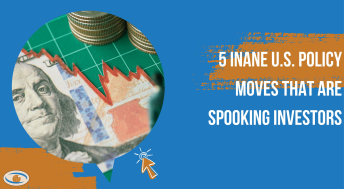"It is far better to at least be aware of some possible negative signs before you buy a stock."
We get a lot of questions at 5i Research along the lines of, “Is there any way I could have known that my stock was going to drop 45 per cent?” Unfortunately, there is no magic solution.
This year was especially frustrating because companies in many instances did well (strong revenue growth, strong cash flow) and yet their stocks still fell. It’s been the year of the macro: nothing really matters except inflation expectations and interest rates.
We are hoping things will get back to some form of normalcy next year. But investors can still take some steps to protect their portfolios just in case we are in store for another wild ride. Let’s look at five potential red flags to watch out for when choosing your next stock.
None of these factors guarantees anything, of course, and sometimes even the best stocks will decline in certain market conditions. But the five factors below should certainly be examined before you make any investment decision, since it is far better to at least be aware of some possible negative signs.
Short interest
We do not like to give most short sellers, especially the short-and-distort crew of funds that attack Canadian companies with ugly and often incorrect reports (as happened with Saputo Inc. this week). But you should at least know the short position on a company, and the reason behind any large short interest.
At the very least, learning why there is a short position will make you aware of some of the risks in your investment, and prevent you from buying with only your rose-coloured-everything-is-fine glasses on. Some of the most-shorted stocks this week (in terms of days to cover) are Algoma Central Corp. (91 days), Wildbrain Ltd. (78 days) and Frontera Energy Corp. (62 days).
A high short position can mean potential future buying, and it can mean a possible short squeeze. But it also means some (mostly smart) investors are taking a big bet against your company. You should at least find out why.
Inventory or receivables rising faster than sales
Sorry, this one requires some math, but investors should always look at receivables and inventory levels in relation to sales when considering a company. Look for consistency: if sales rise 10 per cent, then a 10 per cent increase in inventory is OK, but a 25 per cent rise is not.
Sure, the company might be building inventory for a future growth spurt. But just as likely — if not more likely — the company’s expectations for sales are wrong, and its inventory is building because customers are not buying as fast as expected.
This can hurt two ways. Customers might have too much and thus back off making new sales orders for a period of time, resulting in weak future sales growth at the company you are investigating. Or, worse, you might see the company take a writedown as its inventory becomes obsolete and unsaleable.
Similarly, one needs to watch receivables. If they are growing faster than sales, it could mean your company is offering favourable payment terms in order to secure more sales, or, much worse, it is having trouble collecting on customer invoices.
Declining sales
As growth investors, we will hardly ever be that interested when a company is reporting lower sales year over year. But in an inflationary environment, this becomes even more of a potential red flag.
If inflation is running at eight per cent, and your company is not increasing sales by at least that rate, it is moving backwards. We all know costs are rising, so a two per cent boost in sales really means profit margins are down at least six per cent. Watching this red flag can help you find more companies that potentially have pricing power.
Of course, cyclical companies have widely variable revenue growth, since they are price takers (for example, commodity plays), so declining revenue is less useful as a red flag. But if you happen to find a tech, health-care, industrial, consumer or non-cyclical stock showing declining revenues, just skip it and look for something else.
Insider selling
There are dozens of reasons an insider might sell so insider selling is never a perfect indicator. As a former insider of a public company, I sometimes just needed some money, so I would sell regardless of what was occurring at the company I worked for. It didn’t mean bad news was about to drop.
At this time of year, for tax and portfolio management reasons, there is often more than the usual insider selling. We can accept this. But when looking at new investments, we will always look at recent insider activity.
The red flag is waved when there is consistent and persistent selling across the board from numerous executives. Most companies have quiet periods around quarterly earnings periods, and we also don’t like to see a massive increase in insider selling the second these quiet periods end (why are insiders so desperate to sell some shares?).
We also look at the volume of insider transactions. If an insider owns one million shares and then sells 15,000 of them, we hardly care. But a sale of 300,000 would raise our eyebrows.
Excuses
We can’t stand it when a company blames the weather or competitive forces for its bad performance. Weather happens. Competition exists. Time and time again, we see companies making excuses for bad financial performance. We are not saying things such as bad weather have no impact on businesses — they certainly do. But every other company faces the same issues.
Instead of blaming outside influences, companies should focus on telling investors what they intend to do about it. If supply chain issues are a problem, how will your company prevent this from happening again? If labour is hard to find, how are you enticing existing employees to stay on board?
Take Care,







Comments
Login to post a comment.